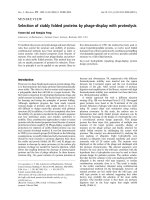Secrets of lockpicking (with comments by ALEx604) steven hampton paladin press
Bạn đang xem bản rút gọn của tài liệu. Xem và tải ngay bản đầy đủ của tài liệu tại đây (716.15 KB, 56 trang )
LOCK PICKING GUIDE ebook is after this message (from page 5)
WIN THE EASY WAY WITH VWD!
Read on to see how you can win the lotto more often.
OPEN TO ALL, WORLDWIDE
‘DreamCar’Owner
YogeshThanksVWD
UKMotoringenthusiastYogeshJethani
(picturedaboveoutsidehishome)is‘overthe
moon’afterbuyinghis‘dreamcar’withthe
helpofVirtualWorldDirect.
‘I’vebeenaVWDmemberformorethana
year,hepointsout,‘and,aswellasbeingvery
financiallyrewarding,thebusinessgivesme
theconfidenceofrealizingthatabsolutely
anythinginlifeispossible.
‘Inowhaveagroupof600peopleandthat
achievementhasenabledmetobuymy
dreamcarandpaythemortgageonabrand
newhome.
‘Thisistrulythemostamazingopportunityto
generateapassiveincomeandplaytheUK
NationalLottoandEuroMillionstheclever
way.
IextendabigTHANKYOUtoVWD.
Frompage1
Thelatesttechnologyhasbeen
installedinVWDmembers’
individualwebsitestosignificantly
broadentheirbusinesspotential.
E-mail:
Tel:01492540236
Fax:01492547854
Post:VWDMemberSupport
BevanHouse
51BevanAvenue
Seebackpagefordirections
Afacilityneverbeforeutilizedinthe
networkmarketingindustryenables
themtodownloadinformationor
thenewe-Lotterymoviedirectly
fromtheirwebsitestotheirmobile
phones.
‘Ibelievethisisthemostpowerful
formofcommunicationeverin
networking,’saidVWDco-founder
TomBrodie.
‘Thisgivesmemberstheabilityto
showthepowerofthee-Lottery
Systemtoanybody,anywhere,
anytime.
‘Allyouneedisamobilephonewith
videoplayback.Themoviecanbe
downloadedfromthetoolssection
ofyourwebsiteandalsotoyour
computer.
‘Thesignificanceofthisisyoucan
organizeapresentationinahotelor
café,usingalaptop,andshowthe
moviewithoutbeingonline.
‘Thebottomlineisweare
embracingthelatestadvancesin
technologytogiveourmembersa
betteropportunity.’
An ideal opportunity to join a company with real
chances to win regularly, through your own
syndicate numbers and through commission from
other players.
This is a picture of a winning e-Lottery
syndicate picking up a cheque for
£139,340.00 GBP from the National
Lottery operator. The syndicate won
two, 5 numbers plus the bonus ball
prizes and 42 four ball prizes on
Wednesday Draw 28/08/2002. Each
syndicate member won £2,843.67 GBP
Te st im on ia ls
M a lcolm H or se y Che lt e n h a m . UK.
” Since I j oined VWD not only have I had m ore lot t o wins
t han I 've ever had before, I 'm act ually earning
subst ant ial ext ra incom e showing friends how t o play for
FREE” .
Pa u l Ve ve r k a , En gla n d, UK
I n m y 8 years of searching for a way t o supplem ent m y
incom e, Virt ual World Direct has proved t o be t he m ost
excit ing and unique opport unit y. From t he m om ent I
j oined, I knew t his was som et hing special. Weekly wins
keep happening and I 'm also get t ing paid for int roducing
ot hers t o t he e- Lot t ery syst em . Now I 'm now earning
t he equivalent of a good full- t im e incom e. Cust om er
service is first class and t he lit erat ure and websit e are
fant ast ic . I t 's t ruly am azing t hat t his is all happening for
on ly 5 .0 0 a w e e k !"
Colin M it ch e ll , En gla n d, UK
Wit hin t hree m ont hs of playing t he e- Lot t ery syst em I
had four Lot t ery wins and £ 2 ,8 4 6 .9 5 deposit ed int o m y
Virt ual World Direct account . I t 's not j ust about winning
big but winning regularly.
D a n Va lt e r , Ca n a da
I j oined Virt ual World Direct at t he end of 2002 and
since t hen I 've been a winner dozens of t im es and seen
m y business grow bet ween 9 and 20% every m ont h.
Now m y com m issions add up t o m ore t han an average
em ployee m akes in salaries.
The VWD program m e is sim ple, com plet ely global and
FUN. The websit es and t he funct ionalit y work Brilliant ly.
The concept is unique and wit hout com pet it ion and t he
m anagem ent ( Tom and Len) are wise and considerat e
and on t op of significant growt h. I am looking forward t o
m any years of prosperit y, enj oym ent and co- operat ion
wit h VWD.
M a u r e e n Be ll, En gla n d
Since j oining t he e- lot t ery m ult i win syndicat e syst em –
wit h which £5 ent ered m e int o BOTH t he Wednesday
and Sat urday draw – I have won an am azing 12 t im es.
My part ner has won 4 t im es and m y t wo cousins in
Aust ralia won £ 2 4 5 a ft e r be in g in only 1 0 da ys. Now
because of t he am azing rewards syst em we are all
ent ered int o t he Wednesday and Sat urday draw FREE of
charge. This really is a business for EVERYONE! Most
people play t he lot t ery – why not j oin a syst em t hat
gives t hem 8 8 lin e s a w e e k t h a t COSTS £ 5 in st e a d
of £ 8 8 and a gu a r a n t e e d W I N N I N G n u m be r .
Show t he m a be t t e r w a y!
Wit h VW D - your friends, fam ily and colleagues can enj oy playing t he UK Nat ional Lot t o from
t he com fort of t heir arm chair wit h ALL TH ESE AD D ED BEN EFI TS.
•
No t rudging t o t he shops, st anding in queues or lost t icket sOdds as low as 1 in 13 88
ent ries a WEEK for j ust £5.00 Unique prizes not feat ured in t he UK Lot t o including a 2
ball winHit t he JACKPOT wit h j ust 5 num bersWin m ore wit h t he e- lot t ery t han if you
play on your ownPlay for FREE t hrough t he VWD Rewards program m e
•
Result s by E- Mail w it h w inn in gs pa id ou t im m e dia t e ly
Plu s, Plu s, Plu s – W a t ch t he 3 m inut e m ovie for m or e de t a ils!
What 's More t here are around 2 0 M illion Pe ople a w ee k a ct ive ly pla yin g t he UK Nat ional
Lot t o wit h m any m ore worldwide.
The UK Nat ional Lot t o is one of t he m ost prest igious, t ax free, lum p sum lot t eries in t he world
and it s popularit y is im m ense.All of t hem would like t o know how t o get t he a dva n t a ge and
phe nom e na l pla ying pow e r of t he e- lot t ery syst em by j oin in g VW D !So click t he link below
and st art enj oying a bet t er way t o play t he UK Nat ional Lot t o and gain an e a sy w a y t o build
a n on lin e busin e ss!
YES! – Sh ow m e a Bet t er W a y t o Pla y a n d Ea r n !
Sim ply e m a il a n dy@ba ile ys.t v or visit
w w w .t e a m pla ylot t o.com t o fin d ou t
By Steven Hampton
Originally Published by Paladin Press (c) 1987
(don't let the date fool you. This is good stuff)- Dr Bloodmoney
(brought to you by
Dr. Bloodmoney)
[Converted to pdf / edited / updated by: ALEx604 Oct., 31st 2001
Shouts to Midirain, Draven, Wolfe347, Netdenizen, The Redwood Mafia]
( "Well, I'm bringing you this file because I have a scanner and an
OCR package and I like to pick locks. This file is a complete transcription
of the book, Secrets of Lock Picking by Steven Hampton, minus the chapter
on warded locks (These locks are cheap. Use a hammer and a screwdriver).
Before getting on to the subject, I would just like to use this opportunity
to say that you can not just read this file and know how to pick locks. It
does take practice. The good news is that by practicing you will learn how
to open locks. And fast, too. I have heard many people say "It's not like
the movies... it takes time to pick a lock." Well, sometimes that's true, but
I have picked a Sargeant six-pin, high-security tumbler lock in three seconds.
And other similar locks in the the same time frame as well. So I know that
it can be done. But don't worry. Practicing is not boring. There is a
certain thrill present when you pick a lock for the very first time.
Imagine the sensation of knowing that you can get into almost anywhere you
want. Believe me when I tell you that it is very cool."- Dr. Bloodmoney)
(1 of 52) [10/18/01 12:45:53 PM]
[" I converted this to pdf because I prefer the format. I also like to pick locks, in fact I like to go to apartment buildings, enter their basement
storeage area, and steal the locks. (Note: I only steal the locks on the storeage lockers, leaving everything else. Love the panic. They should
buy better ones, anyway.) I have added a bit of personal updates herein, mainly to do with round tumbler locks, and other things that I have
picked (pun intended) up. I have tried to place all of Dr. Bloodmoney's comments in round brackets, and any that I have added in square
brackets. Just one more note: This is of course is a document which breaks every copyright law from the western world to the place where the
sun rises. Steve Hampton deserves the main credit here for; first off working with Paladin Press; and second, of all coming up with idea to
make this book. Since the introduction of the internet artists and writers claim that people like us fuck them over for their royalty check, when
in actual reality the publishers are the ones who screw them. I am asking on behalf of Steve Hampton that you, the reader, send him a buck
care of Paladin Press. Make sure it's a money order, not a check and do not place your return address, add a note to the M.O. saying it's
money you owe him for stealing a copy of his book. This should really piss off most of the corporate assholes out there that messed up
Napster."- ALEx604]
Contents
Introduction
Tools
Lock Identification
Pin Tumbler Locks
Wafer Tumbler Locks
Double Wafer Locks
Pin and Wafer Tumbler Padlocks
Tubular Cylinder Locks
Mushroom and Spool Pin Tumbler Locks
Magnetic Locks
Disk Tumbler Locks
Tips for Success
INTRODUCTION
(2 of 52) [10/18/01 12:45:53 PM]
The ancient Egyptians were the first to come up with
a complicated security device. This was the pin tumbler
lock. We use the same security principle today on millions
of applications.
The most commonly used lock today is the pin tumbler
lock. A series of pins that are divided at certain points
must be raised to these dividing points in relationship to
the separation between the cylinder wall and the shell of
the lock by a key cut for that particular series of pin divisions. Thus the cylinder can be turned, and the mechanism
or lock is unlocked.
Lock picking means to open a lock by use of a flat piece
of steel called a pick. Actually, the process requires two
pieces of flat steel to open cylinder locks. It amuses me
to watch spies and thieves on TV picking locks using only
one tool [001]. But it is for the better in a sense. If everyone
learned how to pick locks by watching TV, we would all
be at the mercy of anyone who wanted to steal from us,
and the cylinder lock for the most part would be outdated.
[001 -Actually, I made a pick out of a hex key. The steal is strong enough to double as a pick and as a tension bar. It is mostly useless on good
quality locks. However, I have noticed that most people buy their padlocks at Walmart, and a single pick made of strong (or "cold") steal will
do the job just fine.- ALEx604]
The actual definition of lock picking should be: "The
(3 of 52) [10/18/01 12:45:53 PM]
manipulation and opening of any restrictive mechanical
or electronic device by usage of tools other than the
implied instrument (key or code) used solely for that
device." A little lengthy, but more accurate description.
With cylinder locks, it requires a pick and a tension
wrench.
By picking the lock, you simply replace the function
of a key with a pick that raises the pins to their "breaking point," and using a tension wrench one rotates the
cylinder to operate the cam at the rear of the lock's cylinder
to unlock the mechanism.
(4 of 52) [10/18/01 12:45:53 PM]
The tension wrench is used to apply tension to the
cylinder of the lock to cause a slight binding action on
the pins as well as to turn the cylinder after the pins have
been aligned by the pick; this opens the lock. The slight
binding action on the pins caused by the tension wrench
allows one to hear and feel each pin as it "breaks" or
reaches alignment with the separation of cylinder and
shell. The vibration is felt in the knuckles and joints of
the fingers, and the sound is similar to that of a cricket
in an arm wrestling match-a subtle yet distinct click.[002]
[002 - Forget about hearing the pins, on occasion you can feel them slip. Applying a rocking motion to the tension bar, without letting all the
tension go will speed up the process. You should be able to get a chain of padlocks two and a half feet long picked in under 5 minutes. Then
you can say you can pick locks. - ALEx604]
Usually you need very little tension with the wrench
while picking the lock. In fact, it takes somewhat of a
delicate, yet firm touch. This is the secret to picking locks
successfully-a firm and yet gentle touch on the tension
wrench. You should be able to feel the pins click into place
with the right amount of tension; experience will be your
true guide.
Half of your success will be based on your ability to
use or improvise various objects to use as tools for your
purpose. The other half will depend on practice. I once
picked a pin tumbler lock using a borrowed roach clip
and a hairpin. A dangerous fire was prevented and probably several lives were saved. The world is full of useful
(5 of 52) [10/18/01 12:45:53 PM]
objects for the purpose, so never hesitate to experiment.
TOOLS
I started picking locks using a small screwdriver and
a safety pin. The screwdriver can be used as a tension
wrench, and the safety pin is used like a "hook" pick.
The last half inch of the screwdriver's tip was bent at a
45 degree angle so as to allow easy entry for the pick (bent
safety pin). Do not heat the screwdriver tip to bend it,
as this will destroy its temper. Use a vise and hammer to
do the job. Bend slowly by using firm and short taps of
the hammer, otherwise you may break and weaken the
shaft. The safety pin should be about one and a half inches
long and bent in the same way.[003]
[003 - How to make custom picks by ALEx604... First off, you need the right material. Hacksaw blades are the best. Try to get the type where
the metal is harder on the back of the blade and "softer" at the teeth. Asking around at a good hardware store, and they will tell you what I
mean by that. Cut the hacksaw blade in half. Choose one piece as your pick, the other as your tension bar. (see the figures in this pdf for
shaping them) I use black electrical tape for covering the area I use as a handle, leaving space for the hole so I can collect them on keyrings. (
Make a bunch of them, odd little changes will show you that different ones you've made can be used for different brands of locks.) Grind
them down on a fly wheel to the desired shape of the picks and tension bar. - ALEx604]
With the small screwdriver as a tension wrench, you can
use more of a turning or twisting movement than with
a regular tension wrench so you will generally need less
direct force when using it. As I mentioned earlier, with
(6 of 52) [10/18/01 12:45:53 PM]
practice you will develop the feeling for the right amount
of tension on a cylinder. If the safety pin bends after a
short time, use the keyway of the lock you are picking
to bend it back into shape. Even after several times of
bending, it should still be useful. Keep a few spares handy,
though. File the tip of the safety pin flat in relationship
to the bottom of the pins in the lock. Smooth any sharp
edges so that you won't impale yourself. Also, if the tip
is smooth, the pick will not get hung up on the pins while
picking the lock.
Granted these are not the best tools for the job, but
they do work. If you learn to use your junk box as a rich
source of equipment, then with your experience real lock
picks will give you magic fingers. Also, you'll have the
advantage of being able to improvise should you be
without the real things {which are illegal to carry on your
person in most parts of the country}.[004]
[004 - Picks and tension bars are illegal everywhere. The trick to carrying them is to have them connected to something which is legal. They
can be made to go with/look like they belong to a set of tools for collecting rocks, or whatever. Use your imagination, just be sure to have all
the tools for your creative answer on you as well. Course, if the cops actually caught you picking a lock, your in shit. Just keep your month
shut and get a lawyer. - ALEx604]
Lock picks are difficult to get. I received my first set
when I became a locksmith apprentice. All of my subsequent sets I made from stainless steel steak knives with
a grinder and cut-off wheel. They are much more durable
than the commercial picks. If you do make your own,
(7 of 52) [10/18/01 12:45:53 PM]
make certain that the steel is quenched after every 3
seconds of grinding-do not allow the pick to get hot to
the point of blue discoloration.
A diamond pick is the standard pick I use on most all
pin and wafer locks. A small diamond pick is used for
small pin tumbler locks such as small Master padlocks,
cabinet file locks, etc. The tubular cylinder lock pick, we
will discuss later. The double-ended, single-pronged tension wrench is used with the diamond pick. It features
double usage; a small end for small cylinders and a large
end for the larger cylinders. A special tension wrench is
used for double-wafer cylinder locks with an end with two
prongs on one end and tubular cylinder locks with the
single prong on the other end. We will discuss tubular
cylinder and double-wafer locks later as well. The steel
should be .030 inches to .035 inches thick for the picks
and .045 inches to .050 inches thick for the first tension
wrench mentioned above. The second tension wrench
should be .062 inches square (.062 inches x .062 inches)
on the tubular cylinder side (one pronged end), and .045
inches thick on the double-wafer end (two-pronged end).
You can accomplish this by starting out with .045 inches
in thickness. The two-pronged end should be bent carefully
in a vise at a 30 degree angle. This allows easy entry for
the pick on double-wafer locks.
(8 of 52) [10/18/01 12:45:53 PM]
Among the more common tools used by professionals
around the world is the rake pick. The rake pick is used
to "rake" the tumblers into place by sliding it in and out
across the tumblers. I seldom use the rake pick because
it is not highly effective and I consider it a sloppy excuse
for a lock pick. I've seen the rake pick work on some difficult locks, but you can rake with a diamond pick and
get the same results. I prefer the diamond pick for most
tumbler locks simply because it is easier to get in and out
of locks-it slides across the tumblers with little or no
trouble.
(9 of 52) [10/18/01 12:45:53 PM]
A ball pick is used for picking double-wafer cylinder
locks, though I never carry one; I use a large diamond
pick and reverse it when picking these locks. This means
I have one less pick to carry and lose.
A double-ball pick is used like a rake on double-wafer
(10 of 52) [10/18/01 12:45:53 PM]
locks in conjunction with a tension wrench (two-pronged
end).
A hook pick is used to open lever tumbler locks, though
again, I use a diamond pick with a hooking action when
possible. There are various sizes of hooks but they all have
the same basic job-to catch the movable levers that
unlock lever locks.
There are also various sizes of tension wrenches. They
are usually made from spring steel. The standard tension
wrench is used for pin and wafer locks. A special tension
wrench is called a Feather Touch, and it is used for highsecurity mushroom and spool pin tumbler locks. Its
delicate spring-loaded action allows the pick to bypass the
tendencies of these pins to stick. A homemade version of
the Feather Touch can be made from a medium-light duty
steel spring.
As to getting lock picks for your own use, you cannot
go down to your local hardware store and buy them. I
could supply you with some sources or wholesalers, but
I do believe it is illegal for them to sell to individuals. Your
best bet would be to find a machine shop that will
fabricate them for you. It would be less expensive and
arouse less suspicion if you purchase a small grinder with
a cut-off wheel and make your own. With a little practice, you can make a whole set in an afternoon. Use a copy
(11 of 52) [10/18/01 12:45:53 PM]
of the illustrations in this book as templates and carefully
cut them out with an X-ACTO knife. Cut down the middle
of the lines. Acquire some stainless steel (many steak
knives approach proper thickness).
With a glue stick, lightly coat one side of the paper
template and apply it to the cleaned stainless surface, and
allow it to dry. You'll need a can of black wrinkle finish
spray paint. This kind of paint has a high carbon content and can stand high temperature of grinding. Spray
the stainless (or knives) with the patterns glued on and
dry in a warm oven or direct sunlight for one hour. Set
aside for twenty-four more hours. Peel off the paper
template and you are ready to cut and grind. Please use
caution when cutting and grinding. The piece should be
quenched every three seconds in cold water. Smooth up
sharp edges with a small file or burnishing wheel.
Tools made from stainless steel will outlast the purchased ones. The tools purchased from most suppliers are
made from spring steel and wear out after about 100 uses.
The stainless steel ones, if properly made, should last over
2,000 uses.
LOCK IDENTIFICATION
(12 of 52) [10/18/01 12:45:53 PM]
There are many types of locks, the most common being:
1. The pin tumbler lock. Used for house and garage doors,
padlocks, mail boxes, and Ford automobiles.
2. The wafer tumbler lock. Used for garage and trailer
doors, desks, padlocks, cabinets, most autos, window
locks, and older vending machines.
3. The double-wafer lock. Used for higher security wafer
tumbler applications.
4. The warded locks. Used for light security padlocks and
old-fashioned door locks.
5. Lever locks Used for light security and older padlocks,
sophisticated safe-deposit boxes, some desks, jewelry
boxes, and small cash boxes.
6. Tubular cylinder locks. Used for alarm control systems,
newer vending machines, car-wash control boxes and
wherever higher security problems might exist.
These locks are the more common locks used yet there
are variations and combinations of these principal types
that usually pick open in the manner that will be discussed.
(13 of 52) [10/18/01 12:45:53 PM]
Some of them just require practice of the basic types,
others luck, and most of the rest of them knowledge of
how that particular lock works and is keyed. This comes
from experience.
PIN TUMBLER LOCKS
(14 of 52) [10/18/01 12:45:53 PM]
Pin tumbler locks offer the most security for their price.
They have close machine tolerances and approximately
1,000,000 different key combinations for a five-pin lock.
Considering the thousands of different companies making pin tumblers (different shaped keyways for each company or design line), the chances of someone having a key
that will work in your front door lock are one in many
billions.
Pin tumbler locks can easily be identified by peering
down the keyway and locating the first round pin.
Sometimes you can see the pin's dividing point, where it
breaks with the cylinder wall (shear point).
To successfully pick a pin tumbler lock, your sense of
touch sould be honed so that both hands feel the tools.
Once the hand holding the pick has located a slight relief
in tension while picking a particular tumbler, the other
hand holding the tension wrench will feel a relief or breaking point. Both hands should be involved with the sense
of touch, the sensing of the inner workings of the lock.
We are now ready to begin the first lesson. First open
your front door and check for a pin tumbler lock on it.
(15 of 52) [10/18/01 12:45:53 PM]
It should have one on it. If there is one, leave the door
open to decrease suspicion. Do not lock yourself out of
your apartment or house by being overconfident; not only
will you raise suspicion, but window glass is not cheap.
HOW TO PICK A TUMBLER LOCK
STEP ONE
Without using the tension wrench, slip the pick into
the lock. The "hook" of the pick should be toward the
tumblers (up in most cases, depending on whether or not
the lock was mounted upside down-you can tell by looking down the keyway and locating the first pin with your
pick). Try to feel the last tumbler of the lock. It should
be 7/8 inches into the lock for a five-pin tumbler lock
(most common pin tumbler lock used).
Make certain that you have no tension on the wrench
when inserting the pick as this will encumber the frontal
tumblers. When you feel the back tumbler, slowly raise
it with a slight prying motion of the pick. Release it, but
keep the pick in the lock on the rear tumbler.
Now insert the tension wrench, allowing room for the
pick to manipulate all of the pins. It should be placed at
the bottom of the cylinder if the lock was mounted
upright, tumblers toward the top of the cylinder. Apply
(16 of 52) [10/18/01 12:45:53 PM]
firm and yet gentle clockwise pressure to the tension
wrench.
Slowly raise the back tumbler with a slight prying motion of the pick. A minute click will be felt and heard when
it breaks. It will lose its springiness when this occurs, so
do not go any further with it. Any further movement with
the pick will cause binding by going past the pins' shear
line. Continue an even pressure with the tension wrench.
Keeping an even tension pressure, proceed to Step Two.
STEP TWO
The fourth tumbler should be easily felt since it is the
next one in line. Raise it until it breaks, keeping the tension wrench steady. It too will give a sound and sensation when it breaks or aligns.
STEP THREE
The third or middle tumbler is next. Again, it too will
click. Maintain a constant, even pressure on the wrenchabout the same pressure that you would use to replace
a cap on a catsup bottle. You may feel the "clicks" in your
tension wrench as well as hear them.
(17 of 52) [10/18/01 12:45:53 PM]
STEPS FOUR AND FIVE
Continue on to the next tumbler out, working toward
you. When it breaks, raise the last (front) tumbler to its
braking point and the cylinder should be free to rotate
and unlock the door. Sometimes you may have to play
with the wrench to open the lock because you may have
raised a tumbler too high, past its breaking point. If this
is the case, very slowly and gradually release the tension
wrench pressure and the overly extended tumbler will drop
into its breaking point before the other tumblers have a
chance to fall. The cylinder should pop open at that point.
I have found that this technique is responsible for over
(18 of 52) [10/18/01 12:45:53 PM]
30 percent of my successes in opening all tumbler locks.
If the lock still refuses to open after all that treatment,
release the tension wrench pressure, allowing all of the
tumblers to drop and start over. You may have more than
one tumbler too high and would be better off to repeat
the picking process.[005]
[005 - Ok ..... that was a lot, and a bit over descriptive. The quick way, (which doesn't always work, dense the reason for not cutting out
anything in this text) is to put the pick into the lock with the tooth facing the pins, as far back as you can without to much pressure. Wiggle it
up and down, side to side to make sure you know where the "back" of the last pin is. Then after inserting the tension bar (and applying a little
pressure to the tension bar in the clockwise way, sometimes anti-clockwise.) "Rake" the pick in and out, until the tension bar turns the lock. ALEx604]
WAFER TUMBLER LOCKS [006]
[006 - Wafer-plus-locks OR "Disk pin locks" - I wasn't sure where to insert this so I decided on the beginning of the Wafer Lock area: Disk
Pin Locks (DPL) are a real pain in the ass to pick, therefore they are fun once you get the hang of it. DPL's look from the outside like wafer
locks. However, the internal pins are more like washers used for nuts and bolts, with a slot cut into them to allow key access. A good way to
view in your mind what I am talking about is to think of a cheap diary bought at dollar store. The dairies that are sold with a cheap lock
connected to them. Some of them have a disk that is turned to open the lock, others use a spring lock like handcuffs. The one with the disk is
what I am talking about. Now imagine there are six disks, separated like the wafer pins in the wafer lock figure below. That is a DPL. You
can tell it is a DPL due to the fact that the lock will only turn one way (i.e.: clockwise) whereas a Wafer Lock can rotate in both directions. (
It's because the spring/s are mounted on the side rather then the top like padlocks/ and wafers) The neat thing is that every model I've come
across uses fat keys, which is good due to the fact that the only way to pick these is multiple picks and a one tension bar. You do not need to
"Rake" these pins, just have the same number of Disk type picks (Looks like a tension bar) or multihead head picks and place them where the
disks are. Then just turn the lock with the tension bar. Simple. - ALEx604]
Wafer tumbler locks make up over one-fourth of the
locks in use in the world. Since they are generally easier
to pick than most pin tumbler locks, you will be 75 percent master after fooling around with these mechanisms.
That is why I wrote about pin tumbler locks first-they
are more difficult and make up over one-half of the locks
used today.
(19 of 52) [10/18/01 12:45:53 PM]
The term wafer refers to the general shape of the
tumblers. The wafers are flat, spring-loaded tumblers that
are much thinner than pins and the distance between them
is less. Wafer locks are picked in the same way as pin
tumbler locks, but you must compensate for the smaller
dimensions. You can identify wafer locks simply by looking down the keyway and locating the first flat tumbler.
(20 of 52) [10/18/01 12:45:53 PM]
The last tumbler on most wafer locks is located about onehalf inch into the lock.
Wafer locks are used on filing cabinets, lockers, most
cars, garage doors, desks, and wherever medium security
is required. The only wafer tumbler lock in common use
that is difficult to pick is the side-bar wafer lock. It is the
most popular type of auto lock. This lock is of different
design than most other locks and offers much more security than a regular wafer tumbler lock, or even a pin
tumbler lock.
SIDE BAR LOCKS:
The side bar lock is used mostly on General Motors
cars and trucks since 1935. It is used on ignitions, door,
and trunk locks. Side bar locks are hard to pick because
you cannot feel or hear the tumblers align with the
cylinders breaking point. A spring-loaded bar falls into
place to allow the cylinder to turn when all of the tumblers
are aligned. There is no way to tell when that happens.
One learns to sense the bar while picking so that it seems
to fall into place by itself. But for beginners, I recommend
this technique for emergency openings: Peer down the
keyway and locate the side groove of any of the tumblers
using a pick as a searching tool. Drill a small hole in the
shell of the lock above the bar which is above the grooves
on the tumblers. Since side bar locks have off-centered
(21 of 52) [10/18/01 12:45:53 PM]









